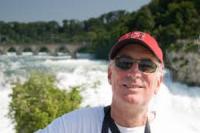-
2017 Cyber Defense Competition tests infrastructure vulnerability

More than 100 college and high school students from nine states honed their cyber defense skills against experts at the U.S. Department of Energy’s (DOE) Argonne National Laboratory during Argonne’s second annual Collegiate Cyber Defense Competition. In the competition, fifteen college teams defended mock electrical and water utilities from the repeated cyberattacks of a team of experts from Argonne, the Illinois and Wisconsin National Guard, and the technology industry.
-
-
Ranking hazardous asteroid effects from least to most destructive

If an asteroid struck Earth, which of its effects—scorching heat, flying debris, towering tsunamis—would claim the most lives? A new study has the answer: violent winds and shock waves are the most dangerous effects produced by Earth-impacting asteroids. The study explored seven effects associated with asteroid impacts—heat, pressure shock waves, flying debris, tsunamis, wind blasts, seismic shaking and cratering—and estimated their lethality for varying sizes. Overall, wind blasts and shock waves were likely to claim the most casualties, with experimental scenarios showing that these two effects accounted for more than 60 percent of lives lost.
-
-
How will the federal government protect nuclear safety in an anti-regulatory climate?

The Trump administration and congressional Republicans have undertaken a wide-ranging effort to shrink the federal government’s regulatory footprint. Much attention has focused on high-profile targets, such as the Environmental Protection Agency. But this trend also has major implications for other agencies. One example is the U.S. Nuclear Regulatory Commission (NRC), which oversees safety across a complex, privately owned network of nuclear power plants, used fuel storage facilities and other sites related to civilian uses of nuclear energy. The NRC and the system it regulates exemplify what some scholars call a “high reliability organization” – one that cannot be allowed to fail, because the consequences would be grave (two examples of failures of external oversight: Chernobyl in 1986 and Fukushima in 2011). A high reliability organization is not automatically a highly reliable organization. Reliability is an ongoing accomplishment involving continuous learning, sustained vigilance and a strong system of checks and balances. Moving forward in an anti-regulatory climate, with so many complex challenges facing the agency, it is essential to ensure independent leadership, public transparency and adequate resources to support the NRC’s mission.
-
-
Sustainability’s threat to fossil fuel industry is only going to increase
Commercial activity in fossil fuels is increasingly at odds with global actions to reduce the threat of climate change. Burning coal, oil, and natural gas is responsible for two-thirds of humanity’s emissions of greenhouse gases, and yet provides more than 20 percent of GDP in two dozen nation states. By Citicorp’s estimate, current commitments to reduce these emissions could mean forgoing $100 trillion in fossil fuel revenues by 2050 — representing a huge disruption to global affairs, undermining national budgets and corporate balance sheets while exposing stakeholders, including pension holders and ordinary citizens in resource-exporting states, to myriad risks.
-
-
Latest science on sea level rise projections: In support of California policy guidance
An estimated 75 percent of California’s population lives in coastal counties. Sea-level rise, already underway, threatens hundreds of miles of roads and railways, harbors, airports, power plants, wastewater treatment plants, coastal wetlands, beaches, dunes, bluffs, and thousands of businesses and homes. In a comprehensive analysis of the factors that affect how much the ocean will rise along California’s coast in coming decades, a seven-member team of experts has provided the state with a report on the best-available sea-level rise science — including recent scientific advances on the role of polar ice loss.
-
-
Cities inland could be reshaped by migration from sea-level rise
When Hurricane Katrina struck Louisiana in 2005, cities inland saw an influx of evacuees escaping the storm and its aftermath. Now, a new study predicts that this could happen again as a result of sea-level rise. Researchers estimate that approximately 13.1 million people could be displaced by rising ocean waters, with Atlanta, Houston, and Phoenix as top destinations for those forced to relocate. The study is the first attempt to model the destination of millions of potentially displaced migrants from heavily populated coastal communities.
-
-
Identifying, utilizing water resources in Africa drylands
Researchers say that by 2050, almost half of the world’s population will live in countries with a chronic water shortage. In African drylands, it is not a water shortage problem, but an inability to capture water for food and other uses. Israeli scientists help villagers in Ethiopia, Zambia, and Uganda to identify water sources and test water quality – and also better capture and use water which is available.
-
-
Smart handpumps predict depths of groundwater in Africa
The amount of groundwater in Africa is estimated to be over 100 time’s greater than annual renewable freshwater sources in the region. Around one million hand pumps supply groundwater to people in rural Africa. Groundwater is used by around 200 million rural Africans every day because it is a widely available, reliable, and safe source of drinking water. Yet according to a new research paper, although groundwater is critical to Africa’s growth and development, there is currently too little data to effectively manage this critical resource.
-
-
Lessons from the Oroville Dam incident

U.S. dams and levees received a grade of “D” in the American Society of Civil Engineers’ 2017 report card on national infrastructure, meaning they are in poor to fair condition and mostly below standard, with many components near the end of their service life. Experts examining the recent Oroville dam incident in California, say that the massive hole in the dam’s primary spillway and excessive erosion in the emergency spillway, along with a levee breach near Manteca, “clearly demonstrate how extreme events, land-cover and land-use changes, and the emerging climatic changes can threaten the integrity of our aging dams and levees.”
-
-
New resilience study helps governments prevent disaster-related loss
Hurricanes, wildfires, tsunamis, and other disasters cannot be stopped, but countries can plan for them — something some areas of the world seem to do better than others, according to a new study. In the study, thirty-eight factors that affect a country’s resilience were derived from national and international databases, and the researchers used these databases to grade the resilience of each country and continent and develop a comprehensive index that includes indicators such as the number of disasters and their death tolls, as well as an area’s population, infrastructure, economy and educational system.
-
-
Urgent action needed to bolster cybersecurity for critical infrastructure
There has never been a more crucial time to examine cybersecurity for critical infrastructure, most of which is privately owned. According to MIT experts, over the last twenty-five years, presidents from both parties have paid lip service to the topic while doing little about it, leading to a series of short-term fixes they liken to a losing game of “Whac-a-Mole.” This scattershot approach, they say, endangers national security. A new report warns of hacking risk to electric grid, oil pipelines, and other critical infrastructure. “The nation will require a coordinated, multi-year effort to address deep strategic weaknesses in the architecture of critical systems, in how those systems are operated, and in the devices that connect to them,” the authors write. “But we must begin now. Our goal is action, both immediate and long-term.”
-
-
Bolstering security in urban centers
The terrorist attack in Stockholm on Friday mimicked previous attacks in Europe, in which terrorists used vehicles to kill civilians. Among the cities in which such attacks were carried out are London, Nice, Glasgow, Berlin, and more. More and more cities are considering the use of bollards to protect not only buildings – but other, “softer” urban areas. The Whole Building Design Guide (WBDG) program of the National Institute of Building Sciences offers a detailed Resource Page with useful analysis of and information about crash- and attack-resistant bollards.
-
-
Earthquake early warning vital for city transit
Although no one can reliably predict earthquakes, today’s technology is advanced enough to rapidly detect seismic waves as an earthquake begins, calculate the maximum expected shaking, and send alerts to surrounding areas before damage can occur. This technology is known as “earthquake early warning” (EEW). An EEW system called “ShakeAlert” is being developed and tested for the West Coast of the United States.
-
-
Potentially explosive methane gas mobile in groundwater, poses safety risk
Potentially explosive methane gas leaking from energy wells may travel extensively through groundwater and pose a safety risk, according to a new study. Researchers found the gas is highly mobile in groundwater, travelling far beyond the shale wells where it is drilled and changing the water chemistry. It will also escape into the atmosphere as a powerful greenhouse gas.
-
-
Monitoring critical minerals to ensure national preparedness
In 2014, the Defense Logistics Agency (DLA) came to a startling conclusion: The United States needed to increase its stockpile of a basic manufacturing material with military applications — yttrium oxide, a material used in laser rangefinders. This shortfall meant that in 2014, the DLA had to submit a request to Congress to acquire new material for the National Defense Stockpile. The DLA has a watch list of about 160 materials, and economists at the agency have developed an early warning system that let them concentrate on high-priority materials.
-
- All
- Regional
- Water
- Biometrics
- Borders/Immig
- Business
- Cybersecurity
- Detection
- Disasters
- Government
- Infrastructure
- International
- Public health
- Public Safety
- Communication interoperabillity
- Emergency services
- Emergency medical services
- Fire
- First response
- IEDs
- Law Enforcement
- Law Enforcement Technology
- Military technology
- Nonlethal weapons
- Nuclear weapons
- Personal protection equipment
- Police
- Notification /alert systems
- Situational awareness
- Weapons systems
- Sci-Tech
- Sector Reports
- Surveillance
- Transportation
Advertising & Marketing: advertise@newswirepubs.com
Editorial: editor@newswirepubs.com
General: info@newswirepubs.com
2010-2011 © News Wire Publications, LLC News Wire Publications, LLC
220 Old Country Road | Suite 200 | Mineola | New York | 11501
Permissions and Policies
Editorial: editor@newswirepubs.com
General: info@newswirepubs.com
2010-2011 © News Wire Publications, LLC News Wire Publications, LLC
220 Old Country Road | Suite 200 | Mineola | New York | 11501
Permissions and Policies
